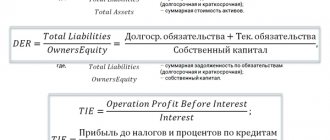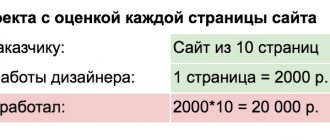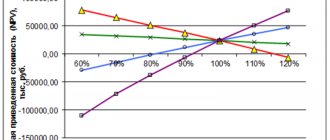46854
0
Author of the article:
Sultanov Iskander Anvarovich
Founder of Projectimo.ru
Recent publications by the author:
Systematic labor standardization project
Implementation of a project to transfer accounting to outsourcing
Anticipation of significant changes in investments
The balanced scorecard, which emerged in the early 90s in the West as a dictate of the times, came into Russian management practice in the 2000s. Initially, it was generally accepted that BSC serves as a powerful motivational regulator of procedural business practices. In this article we will consider the question of what key performance indicators can be successfully applied in project activities. Such experience is gradually gaining more and more importance in modern management.
Brief overview of BSC
The Balanced Scorecard (BSC) theory became known and popular in the minds of managers thanks to the books and activities of two authors R.S. Kaplan and D.P. Norton. One of the essential components of this system are models of motivational indicators, which gradually began to be called KPI (Key Performance Indicators). Due to the difficulties of correct translation, these indicators in the Russian-speaking environment began to be called KPR (key performance indicators) or KPI (key performance indicators). For some reason, the latter has taken root better in the mentality of managers.
KPI models implemented in real business, being part of the balanced scorecard, themselves represent a system integrated into many functional control blocks. Among them, strategic management and personnel management occupy a dominant place.
In recent years, many Russian companies have learned to achieve success in developing strategy. However, the reasons for business failures still lie in the weakness of the methodical development and implementation of programs of specific actions for strategic implementation. The BSC and its key performance indicators are designed to close the gaps that remain between strategy and grassroots processes and development projects.
Company Balanced Scorecard Pyramid
The BSC system is called balanced because it represents a pyramid-hierarchy of goals that has a harmonious logic of decomposition from the vision, mission of the company, through strategy and strategic goals to goals of lower and lower levels:
- financial;
- client;
- process and design and technical;
- business system goals and personnel needs.
As you know, the traditional BSC methodology pays more attention to processes than to design tasks. This state of affairs remained unchanged for a long time. Currently, the architecture of post-industrial business itself is becoming increasingly project-oriented, therefore the need for localizing the KPI system in relation to projects is increasing. Below are two schemes for relaying the strategy down to the components of the project implementation, which do not require separate explanation.
Balanced Scorecard Project Block Model
Dividing the company's projects into two main types within the BSC
Whether we like it or not, our companies are already in the business environment of a new era. And if the path of degradation and bankruptcy is categorically unacceptable, there is no alternative to BSC. The most interesting thing is that in recent years the size of the business has not been an obstacle to the implementation of a balanced KPI system, but there are and will be implementation difficulties. Here, as always, the important thing is the movement towards a full-fledged model; it never works out perfectly the first time.
How to implement a KPI system in your enterprise
Typically, the selection of indicators goes from top to bottom: from the main goals of the enterprise to the development of plans for individual employees. For example:
- We set a goal to increase profits by 20% compared to the previous period.
- Let's look at what factors influence this main indicator.
- We are developing a system of indicators for departments that directly affect the company’s profit.
- We develop metrics for individual employees.
If you decide to implement KPIs at your enterprise, then do not rush to rebuild all the work; start with one unit, for example, the sales or sales department. If your managers use a CRM system, this greatly simplifies the task; most modern products already contain metrics for assessing efficiency and productivity.
Develop a system of indicators that, in your opinion, most influence the results of managers’ work. There shouldn’t be too many of them – ideally, from 3 to 5 metrics that are really important and understandable to humans.
Then start rebuilding the work, invite employees of the “experimental” department, economists, financiers and other specialists who can help in solving the task.
Listen to managers, their immediate supervisor and other employees, together adjust the selected indicator system, tell them what bonuses they will receive from the transition to the new system. Any changes in an enterprise most often cause resistance from people, so you need to try to enlist the support of key specialists.
Personnel motivation in projects and KPIs
A system of performance indicators is built for management purposes by motivating personnel to solve cyclical problems (processes) and unique tasks under constraints (projects). In Russian business practice, sometimes one has to deal with a situation where a project manager is at a loss due to the unclear issues related to the motivation of not only his team members, but also himself. This is one of the significant reasons for the failure of successful endeavors.
Of course, a project-oriented system of personnel motivation needs to be carefully developed and regulated. The key role here is played by the HR director. It should be remembered that all projects are unique not only in the composition of the tasks being solved, but also in the motivational configuration. Using key performance indicators, you need to motivate not only the project team and its manager. This issue should also be addressed in relation to the project office, project management teams and, sometimes, the curator. The KPI system that motivates project participants should include the following.
- Goals of responsible employees and teams.
- Coverage of company employees and third party participants.
- Validity period of motivation.
- Evaluation criteria, its procedures and persons responsible for setting the KPI size.
- Regulation of procedures for penalties and incentives.
- Calendar schedule for calculating KPIs.
- Regulations for the formation of a motivational budget.
It is very important that from the very beginning, at the level of strategy, investment and motivational policies, the company’s policy in the field of motivating personnel engaged in project activities is conceptually established. Some companies don't have this. A budget should be allocated for a fixed part of the incentives for workers involved in project activities, and funds should be raised for bonuses for their successful implementation. In my practice, I have always strived to achieve from senior management a level of bonus fund in the amount of 30-40% of the fixed part of the budget for these purposes.
Model for providing information to the procedure for calculating company KPIs
The budget management system, PMS (project management system) and the KPI system are in close interaction both from the position of the personnel motivation budget and from the position of information support for the calculation base of performance indicators. This is quite natural. Moreover, in many companies, in addition to purely financial plans and reports, the budget management complex integrates a subsystem of labor, technical and other types of regulation. In some companies, on the contrary, the normative planning system completely replaces the budgetary one and works very effectively. Whatever model of financial regulation is chosen, I am convinced that these three systems are best implemented and developed together, because they are parts of the whole.
Purpose
Quantifying workers provides actionable data on their value, records progress, and compares results with competitors. Initially, KPIs were used only in the trade sector, as they make it possible to analyze the work of staff and managers, but now their use is possible in different industries and provides monitoring at all levels of the company.
So, for marketers, this is a demonstration of the success of advertising campaigns and means of attracting potential buyers; for salespeople, it is a mark of market conditions, trading costs, sales and the productivity of sales departments. Financiers use data to analyze liquidity, the attractiveness of a business for investors, and income and expense reporting.
KPIs for project-oriented business
Let us remind ourselves that project tasks in an organization are divided into two large groups: internal corporate development projects and contract-type projects inherent in the nature of a business that has a project type of production. Within the framework of this section, we are interested in the second type of organization, inherent in business in the field of construction, IT development, small-scale and piece production, and consulting activities. In this regard, examples of the development of KPI systems for company projects in these areas are of interest.
The criterion foundation for the effectiveness and efficiency of the project is formed at the stage of developing the project charter. Its components are success factors (indicators of successful implementation), which lay the foundation for the future composition of KPIs. Taking into account the main management functions, stages of project implementation, its content, limitations and risks, we focus on three subject elements of the “triangle of restrictions”:
- "money" or budgetary constraints;
- “time limits” or time limits;
- substantive limitations or “quality” of the project.
The effectiveness of projects is mainly determined by the skillful handling of these three aspects. A system of indicators should be built around them. Both according to the logic of the BSC methodology and common wisdom, budget constraints are paramount for motivating efficiency. It is more advisable to adopt the earned value method (EVM) as a basis for developing relevant KPIs. The purpose of developing indicators for this group is to determine the compliance of the actual work performed with the planned volumes within the budget.
Composition of EVM indicators that serve as the basis for project KPIs
Key performance indicators generated on the basis of the EVM methodology are well applicable in practice using the widespread MS Project. For example, the most accessible indicator - the standard value of CV - cost deviation shows whether the project manager fits into the budget allocated to him or not. We can also distinguish practiced KPIs from the category of indices, among which the CPI indicator is used for the purposes of budget restrictions. It gives a relative assessment of the efficiency of resource use.
The efficiency of project implementation in terms of time is characterized by SV and SPI indicators. Deviation from the schedule can be calculated in monetary units or time units, depending on the adopted measurement logic. This also applies to the index indicator. When considering the issue of meaningful indicators, one cannot fail to take into account the need to complete project milestones on time. So far there is no need to talk about the deployment of full-fledged BSC within the framework of individual project tasks, but element-by-element development of such systems is underway according to traditional components:
- clients;
- processes;
- systems and personnel.
Methods for assessing the effectiveness of investment projects
To assess the effectiveness of investment projects, two methods can be used (
):
- a method based on assessment using undiscounted (simple) indicators ;
- a method based on discounted indicators of the effectiveness of the implementation of an investment project .
Each of these approaches has its own advantages and disadvantages and combines a whole system of indicators.
So, if you use undiscounted indicators for analysis, the calculations will be easier. However, in this case the influence of the time factor on the value of money will not be taken into account.
In other words, all cash flows of the project will be taken into account without taking into account inflation .
But it’s no secret that in an unstable economy, the purchasing power of money is falling. This means that for 1000 rubles in 5 years, you will be able to buy much fewer goods.
So if the inflation rate is, for example, 5%, then 1000 rubles will turn into 783.53 rubles. If inflation rises to 10%, then 1000 rubles received in 5 years will be equivalent to 620.92 rubles today.
And the higher the inflation rate, the more the money supply depreciates.
In this regard, the investor needs to have a clear, understandable comparison of cash flows received at different times. For these purposes, a method based on discounting cash flows is used. It is clear that this method is more accurate, but it is more labor-intensive to evaluate. And for an adequate assessment it is necessary to use the current discount rate . However, if the calculation horizon (life cycle) of the project is long, the relevance of using discounting increases significantly.
Basic principles of web analytics
Finally, I want to give you the basic principles of web analytics:
- For each advertising system we use the analytics service of the same name. If you are running an advertising campaign in Yandex Direct, then you must work with Metrica. If you advertise in Google Adwords, then we work with Analytics
- Set goals. Without goals, a web analyst does not exist. They were mentioned at the beginning of this article
- Configuring widgets, reports and alerts for continuous operation
- For e-commerce, setting up a module for e-commerce
Notes
- ↑ 12
Vishnyakova M. V., 2017, p. 18. - ↑ 12
Panov M.M., 2013, p. 3. - ↑ GOST R ISO 9000-2008 Quality management systems. Fundamentals and vocabulary (Russian) (undefined)
?.
docs.cntd.ru
(10.09.2009). - ↑ Klochkov A.K., 2010, p. 13.
- ↑ Vishnyakova M.V., 2017, p. 19, 273.
- ↑ Vetluzhskikh E. N., 2013, p. 83.
- ↑ Klochkov A.K., 2010, p. 12.
- ↑ Panov M.M., 2013, p. 4.
- ↑ Vishnyakova M.V., 2017, p. 19, 129.
- ↑ Vetluzhskikh E. N., 2013, p. 75.
- ↑ 12
Panov M.M., 2013, p. 106. - ↑ Klochkov A.K., 2010, p. 14-15.
- ↑ Panov M.M., 2013, p. 211.
- ↑ 12
Panov M.M., 2013, p. 81. - ↑ Vishnyakova M.V., 2017, p. 19, 130.
- ↑ Vishnyakova M.V., 2017, p. 133.
- ↑ Vishnyakova M.V., 2017, p. 248.
- ↑ Vishnyakova M.V., 2017, p. 174-175.
- ↑ Vetluzhskikh E. N., 2013, p. 114, 210.
- ↑ Vishnyakova M.V., 2017, p. 185.
- ↑ Vishnyakova M.V., 2017, p. 199.
How to calculate salary
Payroll is calculated based on coefficients. In this case, the percentage is taken into account from the bonus part, and not from the fixed one. Thus, if the plan is exceeded, the employee receives a salary, the usual bonus and a percentage of it for overfulfillment. If the plan is not fulfilled, then the size of the bonus (premium) is reduced.










